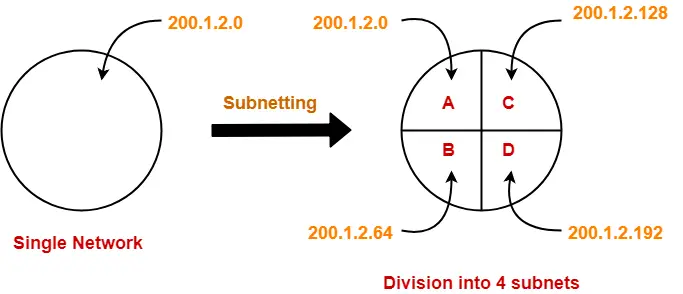Subnetting in Networking-
Before you go through this article, make sure that you have gone through the previous article on Subnetting.
We have discussed-
- Subnetting is a process of dividing a single network into multiple sub networks.
- The number of sub networks created depends upon the requirements.

Subnet Mask-
Subnet mask is a 32 bit number which is a sequence of 1’s followed by a sequence of 0’s where-
- 1’s represent the global network ID part and the subnet ID part.
- 0’s represent the host ID part.
How to Calculate Subnet Mask?
For any given IP Address, the subnet mask is calculated-
- By setting all the bits reserved for network ID part and subnet ID part to 1.
- By setting all the bits reserved for host ID part to 0.
Subnet Mask Examples-
Now, let us discuss some examples on how to calculate subnet mask for any given network-
Example-01:
Consider we have a network having IP Address 200.1.2.0.

Clearly, this IP Address belongs to class C.
In class C-
- 24 bits are reserved for the Network ID part.
- 8 bits are reserved for the Host ID part.
Subnet mask is obtained-
- By setting the first 24 bits to 1.
- By setting the remaining 8 bits to 0.
So, Subnet mask
= 11111111.11111111.11111111.00000000
= 255.255.255.0
Example-02:
Consider a single network having IP Address 200.1.2.0 is divided into 4 subnets as shown-

Now, let us calculate the mask subnet for each subnet.
For each subnet-
- 24 bits identify the global network.
- 2 bits identify the subnet.
- 6 bits identify the host.
For each subnet, subnet mask is obtained-
- By setting the first 26 bits to 1.
- By setting the remaining 6 bits to 0.
So, Subnet mask
= 11111111.11111111.11111111.11000000
= 255.255.255.192
NOTEIn fixed length subnetting, All the subnets have same subnet mask since the size of each subnet is same. |
Example-03:
Consider a single network having IP Address 200.1.2.0 is divided into 3 subnets as shown-

Now, let us calculate the subnet mask for each subnet.
For Subnet A-
For subnet A-
- 24 bits identify the global network.
- 1 bit identify the subnet.
- 7 bits identify the host.
For subnet A, subnet mask is obtained-
- By setting the first 25 bits to 1.
- By setting the remaining 7 bits to 0.
So, Subnet mask
= 11111111.11111111.11111111.10000000
= 255.255.255.128
For Subnet B And Subnet C-
For subnet B and subnet C-
- 24 bits identify the global network.
- 2 bits identify the subnet.
- 6 bits identify the host.
For subnet B and subnet C, subnet mask is obtained-
- By setting the first 26 bits to 1.
- By setting the remaining 6 bits to 0.
So, Subnet mask
= 11111111.11111111.11111111.11000000
= 255.255.255.192
NOTEIn variable length subnetting, All the subnets do not have same subnet mask since the size of each subnet is not same. |
Use of Subnet Mask-
- Subnet mask is used to determine to which subnet the given IP Address belongs to.
- To know more, Read here.
Important Notes-
Note-01:
Default mask for different classes of IP Address are-
- Default subnet mask for Class A = 255.0.0.0
- Default subnet mask for Class B = 255.255.0.0
- Default subnet mask for Class C = 255.255.255.0
Also Read- Classes of IP Address
Note-02:
- Network size is the total number of hosts present in it.
- Networks of same size always have the same subnet mask.
- Networks of different size always have the different subnet mask.
Note-03:
- For a network having larger size, its subnet mask will be smaller (number of 1’s will be less).
- For a network having smaller size, its subnet mask will be larger (number of 1’s will be more).
PRACTICE PROBLEMS BASED ON SUBNET MASK-
Problem-01:
If the subnet mask 255.255.255.128 belongs to class C, find-
- Number of subnets
- Number of hosts in each subnet
Solution-
Given subnet mask
= 255.255.255.128
= 11111111.11111111.11111111.10000000
Since 25 bits contain the value 1 and 7 bits contain the value 0, so-
- Number of Net ID bits + Number of Subnet ID bits = 25
- Number of Host ID bits = 7
Now,
- It is given that subnet mask belongs to class C.
- So, Number of Net ID bits = 24.
Substituting in the above equation, we get-
Number of Subnet ID bits
= 25 – 24
= 1
Thus,
| Number of subnets = 21 = 2 |
Since number of Host ID bits = 7, so-
| Number of hosts per subnet = 27 – 2 = 126 |
Problem-02:
If a class B network has a subnet mask of 255.255.248.0, what is the maximum number of hosts per subnet?
- 1022
- 1023
- 2046
- 2047
Solution-
Given subnet mask
= 255.255.248.0
= 11111111.11111111.11111000.00000000
Since 21 bits contain the value 1 and 11 bits contain the value 0, so-
- Number of Net ID bits + Number of Subnet ID bits = 21
- Number of Host ID bits = 11
Since number of Host ID bits = 11, so-
| Number of hosts per subnet = 211 – 2 = 2046 |
Thus, Option (C) is correct.
To gain better understanding about Subnet Mask,
Next Article- Practice Problems On Subnet Mask
Get more notes and other study material of Computer Networks.
Watch video lectures by visiting our YouTube channel LearnVidFun.

